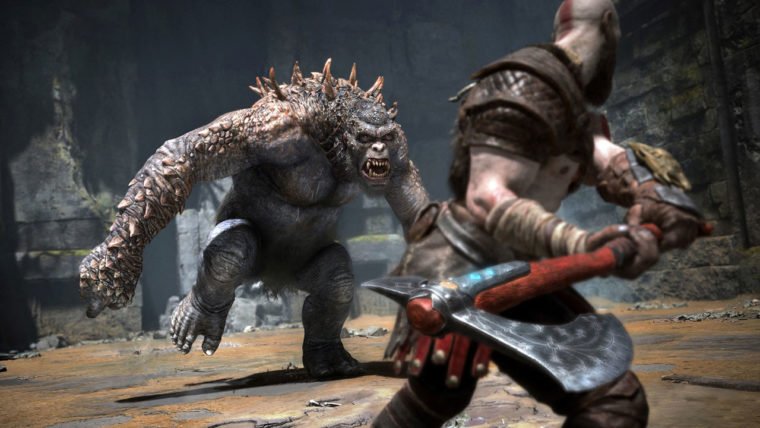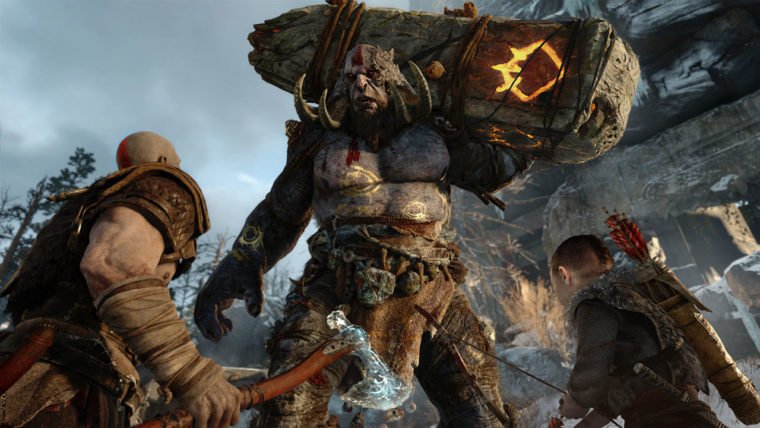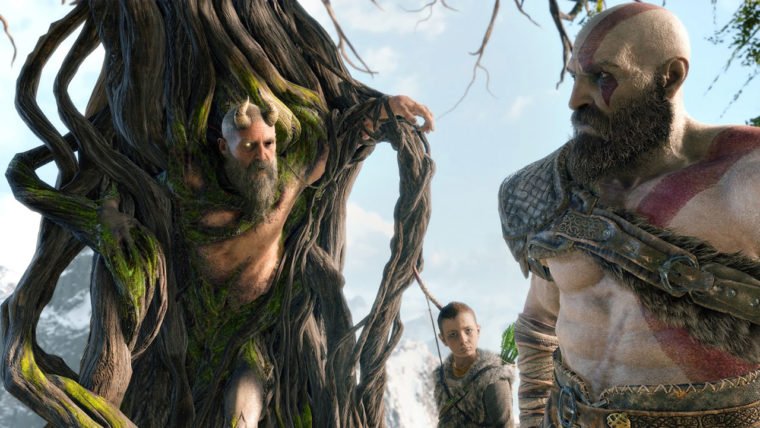There’s a very particular formula that the God of War series has followed since its original release in 2005. It was one of fast-paced hack and slash action with a healthy dose of big boss battles, quick time events and brutal, bloody combat. That story was centered around vengeance, with Kratos seeking revenge for the deaths of his wife and daughter. If you haven’t played those games (spoiler alert), Kratos gets the revenge he sought. He rampaged through the gods of Greek mythology, killing all that stood before him on his way to the summit of Mt. Olympus.
In retrospect they truly are some of the best action games of all time. In each game Sony Santa Monica captured the imagination with the scope of these fabled gods/monsters, and killing them was the ultimate power fantasy. While many thought that the series had been put to bed after the climax in God of War 3, God of War: Ascension, a prequel, released to far less fanfare than the previous games, and it was unclear where Sony Santa Monica could go after that.
God of War is a hard pivot to something more mature
What WAS clear was that they couldn’t just keep going back to that same well. They had told a complete story, how much more could they tell around this central narrative? Where do you go after you’ve killed all the gods? Apparently you start over anew, move to a new land with a new cast of ruling dieties. While it’s still Kratos in the central role of the game, he’s changed and some time has passed. Older and wiser, he’s seemingly put his past behind him, or at least tried to. He’s found peace, married again, and had a son. Unfortunately though, tragedy is never far behind him. While the new God of War never gives you a glimpse of the goings on between God of War 3 to the present, the game begins with Kratos in mourning of his new wife’s passing. He and his son Atreus are preparing for a trip to bring his wife’s ashes to the highest point of the Norse lands. The problem they encounter is that the Gods of this new realm don’t take kindly to another God encroaching on their turf and they’ll do everything they possibly can to stop the father and son from reaching their destination. Of course there are plenty of twists and turns, interesting characters, and great moments in the game for God of War fans that are simply best experienced by playing, so we’re going to leave it at that.
God of War Video Review
More broadly, God of War is a hard pivot to something more mature, something where Sony Santa Monica explores the character of Kratos on a deeper level than has been touched on in previous games. He is different in the new God of War — He’s a father, a teacher, and a role-model. It’s a somber story, with the main goal being to fulfill your wife’s dying wish. Everything else just seems to orbit around this. And while that might sound like somewhat of a boring description, the adventure is anything but. God of War has incredible high peaks of action packed moments and calmer more reflective periods. For fans of the series, there’s just enough resolution to give you satisfaction. Yet there’s just enough tease to let you know that there’s more story to tell here. What it all boils down to is a game that feels more mature and casts a wider net, telling a story that God of War fans can appreciate and others can relate to. While previous games focused on the power fantasy and rage of Kratos, the addition of Atreus into the game alters the narrative tone, but there are gameplay implications as well.

God of War has always been about combat, with Kratos slinging around the Blades of Chaos (among others) and using quick time events for what felt like big, cinematic moments in every battle. A lot has changed here in the new God of War. There are less quick time events. Combat has a more deliberate pace to it and there’s a lot more exploration and light puzzle solving. In almost every aspect, the new God of War has been touched up and modernized, not straying too far away from previous games to make it unrecognizable, but strong moves in new directions nonetheless. On the combat side, Kratos has traded in his trademark blades for a more setting-suitable melee weapon called the Leviathan Axe. He’ll use this in combination with his shield, fists, rage powers, and fancy footwork while in battle. He’s also got Atreus in tow, who is a capable AI companion when it comes to fighting. Atreus moves around the world, controlled by the computer, but the player does control when Atreus shoots his bow and arrow as an attack. Putting all these things together and you’ve got a combat system in the new God of War that feels entirely different than previous games. When you add to that a tighter, over-the-shoulder view, there’s a pretty big shift in both the way the combat looks and plays.
Combat has a slower, more deliberate pace
Battles are more up close and personal, with Kratos needing to pick his dodging and blocking spots accordingly, throwing in rolls, parries, and finishing moves as the opportunities present themselves — while also utilizing Atreus’ skill with the bow and arrow to soften up enemies. The Leviathan Axe is something completely different from other weapons that Kratos has used and it really changes the flow of combat. Kratos can wield the axe as a melee weapon, or use its projectile function. You can whip the axe at enemies and then recall it back to you. It’s an undeniably cool mechanic. Combat is a mixture of old school God of War and modern action RPGs it’s easy to learn but has enough depth to it that allows you to become better and ultimately more powerful throughout the course of the game or successive playthroughs on higher difficulty levels.
These same weapons that Kratos and Atreus use to take down their enemies, they’re using to navigate the world, complete puzzles, and reap rewards. The Leviathan Axe is certainly fun to toss at enemies, but it’s also used in many environmental puzzles in the game. As it has a freezing capability when thrown, it can be used to freeze levers in place and clear paths through hazardous areas. As Atreus grows, so do his skills with the bow and arrow. He’ll learn a handful of abilities that allow the pair to go places that they previously couldn’t, through the use of different arrow types that can create bridges or blow-up certain types of barriers. Being that the game is non-linear, there are many places that are technically reachable at the early parts of the game that can’t be accessed until certain skills are learned.

If there’s a single complaint that we can levy against the core combat in the new God of War, it isn’t because of what’s been changed. The new system is fun, and more challenging that the older games. Where this game falls short is in the boss battles that you’ll encounter on your journey. Sure, this new God of War has plenty of big moments, but they feel a little less impactful than they were in previous games. Perhaps its the introduction to this new world, and the gods that reside here, but I think that’s because almost everyone is familiar with Zeus, Poseidon, Aries, and the laundry list of Greek gods that Kratos vanquished in his younger years. Baldr, for example, is not nearly as well known. Nevertheless, some of the biggest moments in the game do ultimately fall flat if only when comparing it to previous games. What we’ve come to expect from the God of War series is fights with massive bosses, and Sony Santa Monica does a lot of recycling here, with troll bosses standing in for more iconic gods or monsters.
Quick time events far less prevalent than previous God of War games
These troll mini-bosses feel like they’re overused just a little too much and you’ll encounter them numerous times throughout the game . While they have unique attacks, features, and names, they all look somewhat similar to one another. Other than varying elemental attacks these battles end in roughly the same manner — with Kratos slamming a giant rock slab on them for the finishing blow. With quick time events being far less prevalent than previous games, it would’ve been nice to see a little more variety in them when they do pop up. The same can be said of a number of different enemy types and the finishing moves that Kratos uses to deliver a final blow. Typically these moments were where you saw the brutality and anger of Kratos as he ripped a monster’s head off of its body or popped its eye out of socket. The game still features this brutal violence, but it really feels boiled down into a handful of animations that you’ll likely see many times throughout the course of the game due to a lack of variety.
These enemies simply aren’t one size fits all though, they have levels and weaknesses associated with them, so fighting with just a single high level enemy can be a long dance of using all of the aforementioned tools. To tackle the baddest of baddies, you’ll need to be working to improve the skills of Kratos and Atreus by upgrading the skill trees for each of the characters. Kratos can level his weapons, rage attacks, and shield attacks. While Atreus can level his attacking skills as a whole. These levels are somewhat gated by the loot system of the game, in which you must find items that allow you to level your weapons, and you must be a certain weapon level to learn specific skills. There’s a lot more exploration in this God of War game than any before it. You’re constantly tracking down treasures that include things like in-game currency, gems that can be socketed into weapons, or items that allow you to increase your health and rage meters. Each area of the game has numerous treasures to hunt down or environmental puzzles to solve and it’s really up to you in terms of how much or how little you want to trek off of the main path. Puzzles almost always end with Kratos popping open a treasure chest to procure some new loot. Exploration is a big part of the game as it leads to new items and loadout possibilities, but it can be a little overwhelming at times as there is no linear path to a “most powerful character”. While your weapon selection in itself is slim, there’s a variety of different ways to customize Kratos and Atreus in gems that are socketed into their weapons and armor.

Two of the main characters in the game that you’ll meet early on are a pair of Blacksmith brothers who’ll craft you powerful armor in a number of different categories: Chest Armor, Wrist Armor, Waist Armor, Pommels, and Talismans. You can also upgrade your existing armor or purchase new pieces outright. This is a pretty deep system when compared to previous games in the series and I think it adds to the game in meaningful ways that make you want to get out and explore the world to find new equipment, gems, or other items. This deepening of the equipment systems for the series goes hand in hand with the quasi open world elements of the game. God of War isn’t a true open world like, say, Assassin’s Creed for example. There’s a hub called the Lake of the Nine which serves as a starting point for most adventures as it’s both a place that has numerous tributaries that can be explored, yet also holds a Tree which can be used to access different realms. You’ll hit most of these spots across the course of the story, but there’s plenty that you won’t uncover unless you explore a little bit. The story might introduce you to some of these areas, but since the story missions are mostly linear, you’ll want to head back into these different realms to uncover hidden treasures, secrets, trials, and combat sequences. If this doesn’t sound like the God of War that you remember, that’s because it’s really not.
Freedom to explore and customize Kratos and Atreus how you want
This is a new God of War that features many of the different trappings of more modern games, with all of the loot, progression, and exploration that are stuffed into them. That said, all of this stuff doesn’t feel shoehorned into the new God of War either. In fact, after the credits rolled I felt like I had only seen a sliver of what the game had to offer in terms of items to unlock and secrets to find. You do have the ability to go back into the game and explore at will and I’m glad that I did. I found a challenge arena, a host of Valkyrie fights, and a bunch of side content that really gave you a better understanding of the world. There are some NPC nags that you’ll encounter throughout the game that poke you in the direction of checking out side content, but I would’ve liked to experience more of this content before getting to the end of the game where it’s a little less meaningful.

Where God of War does feel familiar is in its presentation. This game is an absolute beauty on the PlayStation 4. There’s a gorgeous art style to the game and it features some of the very best visuals we’ve yet to see on the PlayStation 4. God of War has always been about these larger than life moments that present a sense of scale to the player that just blow you away. At least that’s always been my takeaway from these games. There was always a sense in the older games that you were persevering through the grunt combat to get to that massive, beautiful, book-end boss. This game doesn’t have quite the same pace as previous games, but the big moments are still very much there. And when they are, they are just as amazing as ever. Sure, it’s kind of hard to top the Cronos fight, Posiedon battle, or showdown with Zeus himself, but the new God of War manages to sneak in its own big moments even if it is with lesser known figures.
The new God of War lives up to expectations set by the great games before it
Needless to say, God of War has a very high bar of quality expectations to live up to. For the most part Sony Santa Monica has succeeded. The art direction of the game is absolutely incredible, and while there have been a bunch of great looking games on the PlayStation 4 so far, this is definitely right up there with the very best on the platform. For those looking for an even deeper, immersive experience, you can turn off the hub to take in the visuals without monster levels, health meters, threat indicators, and world compass. Either way, God of War is a great looking, more often than not, jaw-dropping game from a presentation standpoint.
The Verdict
It’s hard to imagine a God of War fan not enjoying this, for all the reasons that we DID mention and some that we’re holding back for the sake of spoilers. Eventhough it has seen considerable changes from previous games in the series, they almost all feel like they were for the better. It’s a bigger, better looking game than any in the series. The tone is a welcome change that shows us a side of Kratos that hasn’t been seen before, while introducing us to a brand new world. There are countless hours to spend on the single player campaign and there’s a ton of stuff to keep you busy on the side. Regardless, this next chapter in the life of Kratos seems like it’s going to be just as interesting as his younger years.











Published: Apr 12, 2018 02:00 am